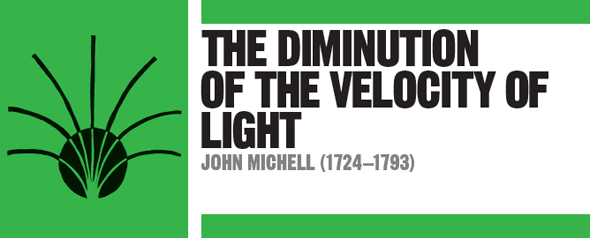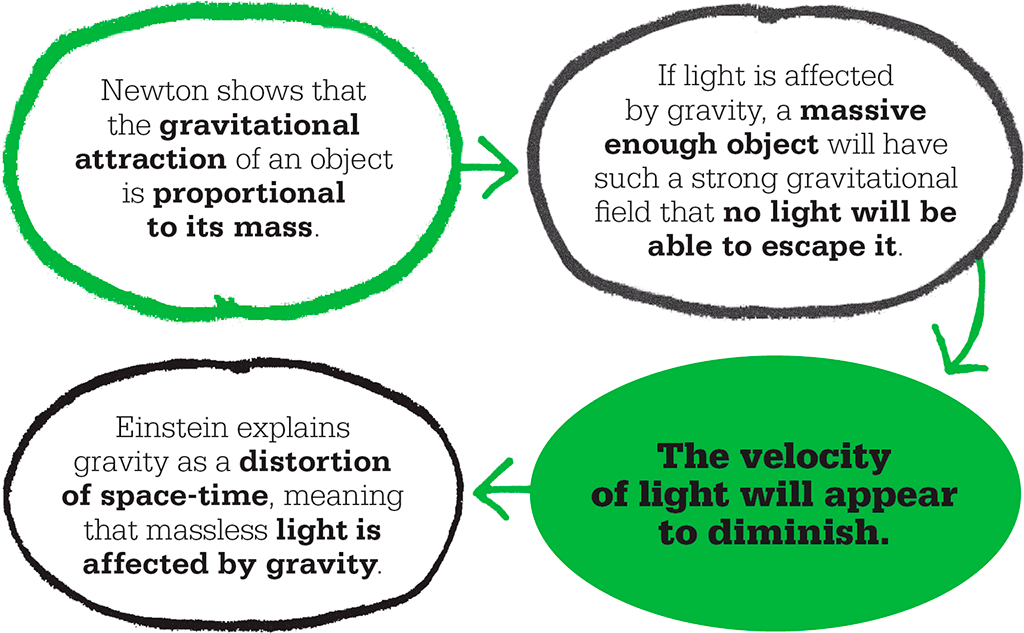
IN CONTEXT
Cosmology
1686 Isaac Newton formulates his law of universal gravitation, in which the strength of the gravitational attraction between objects is proportional to their masses.
1796 Pierre-Simon Laplace independently theorizes about the possibility of black holes.
1915 Albert Einstein shows that gravity is a warping of the space-time continuum, which is why massless light photons are affected by gravity.
1916 Karl Schwarzschild proposes the event horizon, beyond which no data can be received about a black hole.
1974 Stephen Hawking predicts that quantum effects at the event horizon will emit infrared radiation.
In a 1783 letter to Henry Cavendish at the Royal Society, British polymath John Michell set out his thoughts on the effect of gravity. The letter was rediscovered in the 1970s and found to contain a remarkable description of black holes. Newton’s law of gravity states that an object’s gravitational pull increases with its mass. Michell considered what might happen to light if it is affected by gravity. He wrote: “If the semidiameter of a sphere of the same density with the sun were to exceed the sun in the proportion of 500 to 1, a body falling from an infinite height towards it would have acquired at its surface a greater velocity than that of light, & consequently, supposing light to be attracted by the same force…all light emitted from such a body would be made to return towards it.” In 1796, French mathematician Pierre-Simon Laplace came up with a similar idea in his Exposition du Système du Monde.
However, the idea of a black hole would lie dormant until Albert Einstein’s 1915 paper on general relativity, which described gravity as a result of the curving of space-time. Einstein showed how matter can wrap space-time around itself, making a black hole within a region called the Schwarzschild radius, or event horizon. Matter – and also light – can enter it, but cannot leave. In this picture, the speed of light is unchanged. Rather, it is the space the light travels through that changes, but Michell’s intuition now had a mechanism by which the velocity of light would at least appear to diminish.

From theory to reality
Einstein himself doubted whether black holes existed in reality. It was not until the 1960s that they began to acquire general acceptance as indirect evidence of their existence grew. Today, most cosmologists think that black holes form when massive stars collapse under their own gravity, and grow as they assimilate ever more matter, and that a giant black hole lurks at the centre of every galaxy. Black holes pull matter in, but nothing escapes, apart from faint infrared radiation, known as Hawking radiation after Stephen Hawking, the physicist who proposed it. An astronaut falling into a black hole would feel nothing and notice nothing unusual on the approach to the event horizon, but if he or she dropped a clock towards the black hole, the clock would appear to slow down, and approach but never quite reach the event horizon, gradually fading from sight.
Problems with the theory still exist, however. In 2012, physicist Joseph Polchinski suggested that effects at the quantum scale would create a “firewall” at the event horizon that would burn any astronaut falling through it to a crisp. In 2014, Hawking changed his mind and concluded that black holes cannot exist after all.

Matter swirls around a black hole in a doughnut-shaped “accretion disc” before being sucked in. Heat in the swirling disc causes the hole to emit energy – as narrow beams of X-rays.
"Black holes ain’t so black."
Stephen Hawking
JOHN MICHELL
John Michell was a true polymath. He became professor of geology at the University of Cambridge in 1760, but also taught arithmetic, geometry, theology, philosophy, Hebrew, and Greek. In 1767, he retired to become a clergyman, and focused on his science.
Michell speculated on the properties of stars, investigated earthquakes and magnetism, and invented a new method for measuring the density of Earth. He built the apparatus for “weighing the world” – a delicate torsion balance – but died in 1793 before he could use it. He left it to his friend Henry Cavendish, who carried out the experiment in 1798, and obtained a value close to the currently accepted figure. Ever since, this has rather unfairly been known as “the Cavendish experiment”.
Key work
1767 An Inquiry into the Probable Parallax and Magnitude of the Fixed Stars
See also: Henry Cavendish • Isaac Newton • Albert Einstein • Subrahmanyan Chandrasekhar • Stephen Hawking